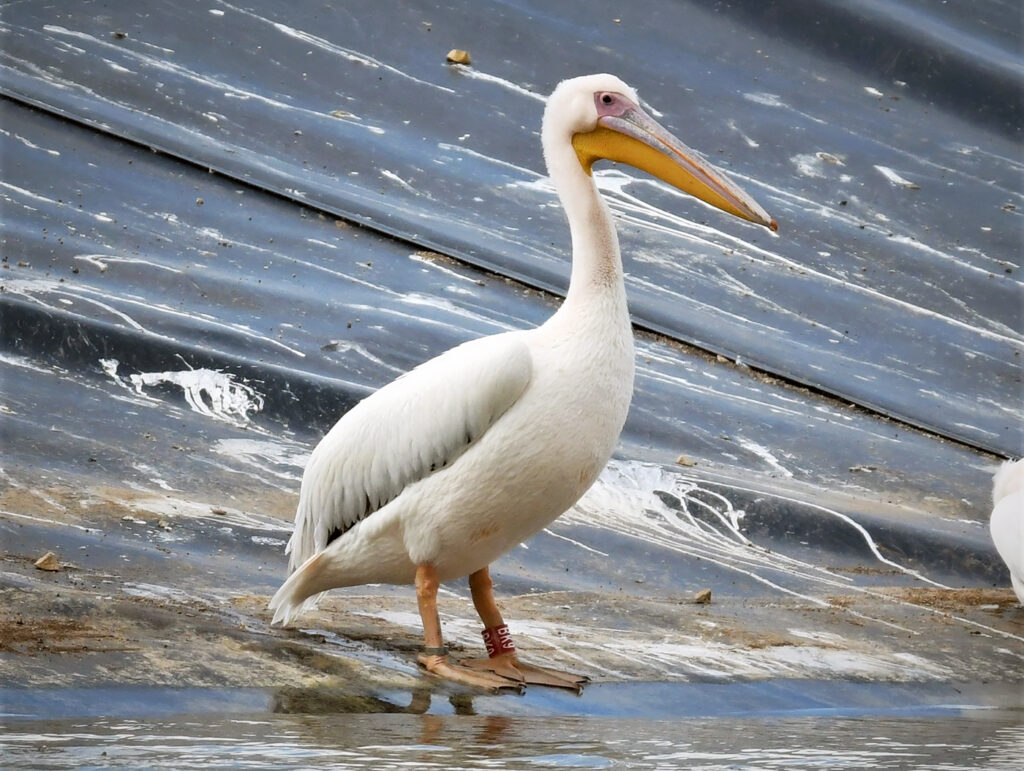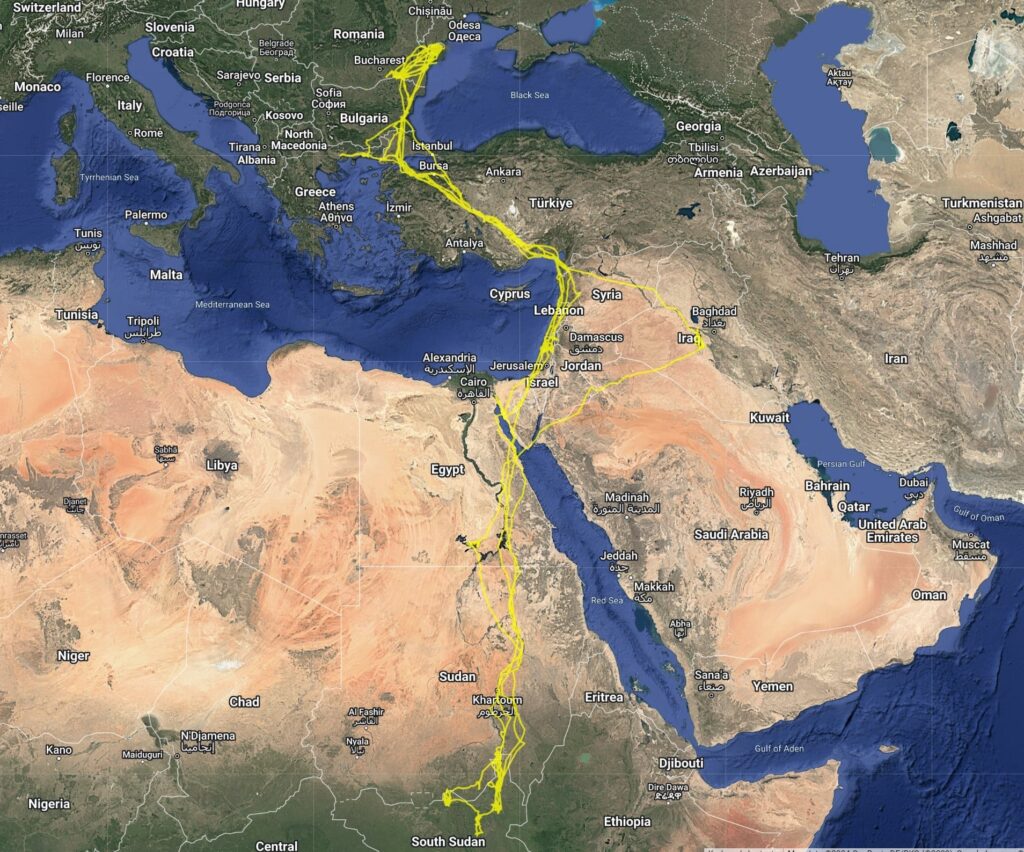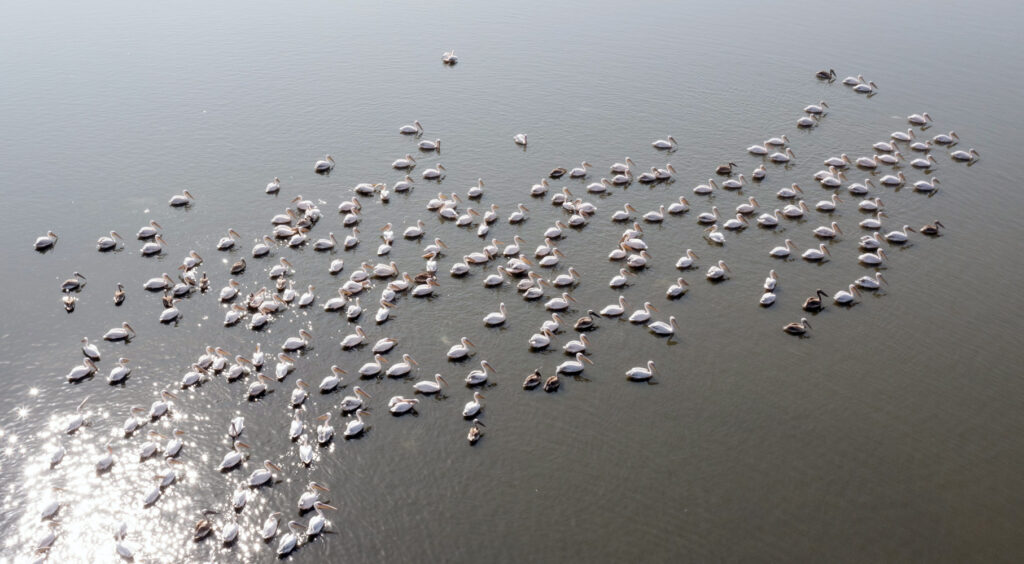It has been three years since the Bulgarian Society for the Protection of Birds (BSPB) started tracking the journeys and adventures of the Great white pelican named Vaya. On September 15, 2021, the team successfully captured and tagged a female Great white pelican with a satellite transmitter in the area of Lake Burgas. This is the first Great white pelican tagged with a transmitter in Bulgaria.

Unlike Dalmatian pelicans, Great white pelicans are pronounced migrants. It is well-known that during migration, tens of thousands of Great white pelicans pass through Bulgaria. Thanks to Vaya, over these three years, the BSPB team has received invaluable and fascinating data about the movements and ecology of Great white pelicans, some of which are new even to scientists studying this species. Over these three years, Vaya has sent nearly 64,000 location points, traveled a total of 55,945 km, and visited 14 countries—Bulgaria, Romania, Ukraine, Greece, Turkey, Syria, Lebanon, Israel, Jordan, Iraq, Saudi Arabia, Egypt, Sudan, and South Sudan.
In her first winter, Vaya decided not to migrate to Africa and spent the winter months in Israel, where she was observed several times by local ornithologists. Fortunately, she managed to avoid the bird flu outbreak in the country at that time. In mid-April 2022, Vaya began her northward migration, stopping for a few days in Syria, central and northwestern Turkey, and the delta of the Maritsa River in Greece, before reaching the Mandra Reservoir near Burgas at the beginning of May. She spent the spring and summer in her favorite area, the Danube Delta in Romania, occasionally visiting Lake Srebarna, Lake Călărași, and the river’s sandbars.

In early September, Vaya reached the Burgas lakes and then headed south, flying over the Suez Canal and following the Nile River to South Sudan, where she spent the winter.
In April 2023, Vaya began her northward migration, spending several weeks in Egypt, Israel, and Turkey before returning to Bulgaria on June 7. She was observed resting on the levees of Lake Atanasovsko. After a few days of rest, our traveler continued north, eventually arriving at Lake Srebarna. She spent the summer at Lake Călărași in Romania, as well as various wetlands in the Danube Delta and the marshes of the island Malyi Tataru, near the city of Izmail, Ukraine.
Like clockwork, in mid-September, Vaya reached the Burgas lakes, and after a few days, she headed south again. Interestingly, after reaching Syria, she continued eastward, reaching Karbala, where she spent about ten days at the lakes west of the city. From Iraq, the bird flew over the Syrian Desert, spending two nights there, before reaching Saudi Arabia. She then crossed the Gulf of Aqaba and Sinai to Egypt, following her usual route to South Sudan. This detour provided scientists with data on a lesser-known migration route for Great white pelicans.
In late March 2024, Vaya began her northward migration again, and by mid-April, she had reached the Burgas lakes. From there, the pelican continued to her usual summer residences—Lake Srebarna, Lake Călărași, and the Danube Delta. On September 17, Vaya began her next southward migration, reaching Lake Eber in Turkey in just four days from the Danube Delta. The BSPB team wishes her a safe and smooth journey to her winter quarters, and next spring will be waiting for her again in the area of the Burgas lakes.

Tagging Great white pelicans with transmitters is being done for the first time in Bulgaria and is a significant advancement in the study of this species. Through data from rings and satellite telemetry, scientists can track the movements of the birds and identify the places where pelicans feed, roost, rest, migrate, overwinter, and breed. Additionally, valuable real-time data is obtained about flight speed, altitude, and patterns. Thanks to the transmitters, conservationists will learn more about the ecology, movements, and threats facing the species, which will help them plan and implement future conservation measures for its protection. The longest distance the bird traveled in one day was 361 km, and the highest flight was recorded at 2,297 meters above sea level.
The activities related to the conservation of Dalmatian and on Great white pelicans are carried out within the framework of the “Pelican Way of LIFE“ initiative (LIFE18/NAT/NL/000716), coordinated by Rewilding Europe and funded by the LIFE Programme of the European Union and Arcadia Foundation, and with the assistance in Bulgaria of the Whitley Fund for Nature.